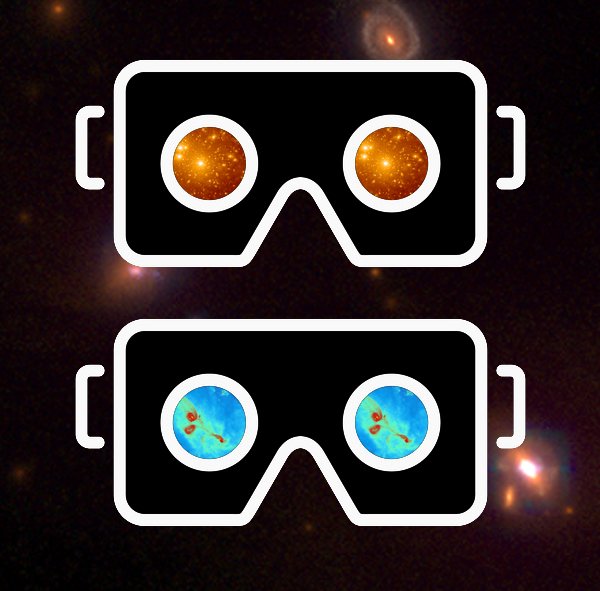Virtual Reality meets Astrophysics

With virtual reality glasses, one can see the distribution of dark matter (top) and gas in the universe (below). Images: Arman Khalatyan/AIP; VR Icon: © subhanbaghirov / Fotolia; Photo montage: AIP
Astrophysicists get their insights of the universe and its objects from analyzing huge amounts of data from observations and simulations of stars, galaxies and other cosmic objects. Elaborate visualization methods make these data tangible.
The videos allow the user to go on a VR excursion through our local cosmic neighbourhood. Its appearance changes dramatically with the kind of objects that are visualized – for instance dark matter, gas or stars. Enigmatic dark matter dominates the cosmic large-scale structure.
Stars and galaxies trace this structure. These three different views of the universe also demonstrate how real astronomical observations work, using different telescopes and instruments to decipher the different objects and building blocks of the universe.
“With simulations and VR we make the invisible visible,” says Arman Khalatyan, an AIP astrophysicist, IT specialist, the initiator and creator of the AIP VR website. He also produced the VR movies and most of the simulations that they are based on. “With simple VR headsets and free apps, VR technology can be used by everyone today. With our platform we now open the universe to everyone.”
The second part of the website invites the visitors to a virtual tour through different astrophysical observatories that are linked to the AIP due to telescope or instrument collaborations. If interested in the sun, one could choose a tour to the “Observatorio del Teide”, for instance. This international observatory is located at 2,400 meters above sea level on the island of Tenerife.
During a virtual tour of the campus one can enter and explore the dome of the solar telescope GREGOR or take a look at the other telescopes of the observatory. In the background one can see the Teide Mountain at 3,718 meter not so far away above the clouds. Fans of architecture may choose the tour to the Einstein Tower in nearby Potsdam. More observatories worldwide are planned to follow soon to extend the website experience.
“With this Virtual Reality project, we would like to tell stories about the universe and encourage the exploration of fascinating locations of astronomical research,“ explains Gabriele Schönherr, an astrophysicist, science communicator and co-initiator of the AIP VR project. “Modern astrophysical observations are an international effort. This thought becomes alive in Virtual Reality.”
Web portal: vr.aip.de
Science contact: Dr. Arman Khalatyan, Leibniz Institute for Astrophysics Potsdam, +49 331-7499 528, akhalatyan@aip.de
Media contact: Katrin Albaum, +49 331-7499 803, presse@aip.de
Further images: https://cloud.aip.de/index.php/s/aJEM3YFquERUoYK
Image 1: Stars in the universe. Credit: A. Khalatyan / AIP, C. Scannapieco, CLUES-Projekt
Image 2: A scientific representation of gas in the universe, based on a computer simulation. Credit: A. Khalatyan / AIP, C. Scannapieco, CLUES-Projekt
Image 3: A 360 degree image of gas in the universe, based on a computer simulation. Credit: A. Khalatyan / AIP, C. Scannapieco, CLUES-Projekt
Image 4: A scientific representation of dark matter in the universe, based on a computer simulation. Credit: A. Khalatyan / AIP, C. Scannapieco, CLUES-Projekt
Image 5: A 360 degree image of dark matter in the universe, based on a computer simulation. Credit: A. Khalatyan / AIP, C. Scannapieco, CLUES-Projekt
Image 6: A 360 degree photo of the “Telegrafenberg” with the Einstein Tower (in the middle) and the Great Refractor (left). Credit: AIP
Image 7: A 360 degree photo of the dome of the solar telescope GREGOR. Credit: C. Kuckein, C. Denker/AIP
The key areas of research at the Leibniz Institute for Astrophysics Potsdam (AIP) are cosmic magnetic fields and extragalactic astrophysics. A considerable part of the institute's efforts aim at the development of research technology in the fields of spectroscopy, robotic telescopes, and e-science. The AIP is the successor of the Berlin Observatory founded in 1700 and of the Astrophysical Observatory of Potsdam founded in 1874. The latter was the world's first observatory to emphasize explicitly the research area of astrophysics. The AIP has been a member of the Leibniz Association since 1992.
Media Contact
All latest news from the category: Physics and Astronomy
This area deals with the fundamental laws and building blocks of nature and how they interact, the properties and the behavior of matter, and research into space and time and their structures.
innovations-report provides in-depth reports and articles on subjects such as astrophysics, laser technologies, nuclear, quantum, particle and solid-state physics, nanotechnologies, planetary research and findings (Mars, Venus) and developments related to the Hubble Telescope.
Newest articles

Superradiant atoms could push the boundaries of how precisely time can be measured
Superradiant atoms can help us measure time more precisely than ever. In a new study, researchers from the University of Copenhagen present a new method for measuring the time interval,…

Ion thermoelectric conversion devices for near room temperature
The electrode sheet of the thermoelectric device consists of ionic hydrogel, which is sandwiched between the electrodes to form, and the Prussian blue on the electrode undergoes a redox reaction…

Zap Energy achieves 37-million-degree temperatures in a compact device
New publication reports record electron temperatures for a small-scale, sheared-flow-stabilized Z-pinch fusion device. In the nine decades since humans first produced fusion reactions, only a few fusion technologies have demonstrated…





















